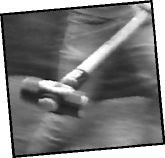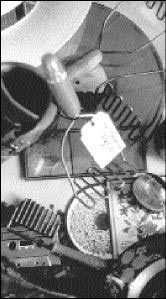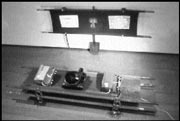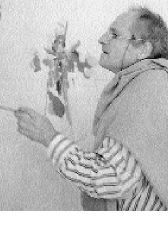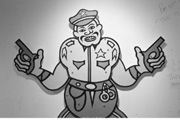BLINK
Kirkland Arts Center, 620 Market, Kirkland 425-822-7161, free 11 a.m.-6 p.m. Mon.-Fri. through Fri., Nov. 16
HAVING WADED THROUGH the pastel yuppie muck that fills the galleries along Kirkland’s main drag to brimming, it’s a relief to turn the corner and find the charming old brick building that houses the Kirkland Arts Center. Once inside, if you haven’t tripped over Debbie Reichard’s small floor installation of iridescent logs, you’ll be hit with another breath of fresh air, this time in the form of experimental conceptual art. Local brainiac visionary Michael O’Maley has assembled the work of seven artists in an attempt to illustrate some of his lofty theories.
O’Maley is a smart cookie. And though his intentions are good, they are perhaps too far-reaching for the scope of this small exhibition. While the artwork is good, it often stands up better on its own than weighed under the statements of an erudite curator grasping to make all the wily hairs fit into a neatly coiffed package.
“Each blink is the point at which the individual interacts with, and perpetually re-evaluates, the wider universe,” O’Maley writes. With “Blink,” O’Maley hopes to explore personal subjectivity in a sea of cultural constructions. What’s really effective in “Blink,” however, beyond any grandiose aspirations to deconstruct cultural iconography, is the work’s ability to play with perception.
Strikingly juxtaposed in the main gallery are Paul Sacaridiz and Jennifer Lapham’s collaborative landscape mural and Debbie Reichard’s fragile-looking log pile. Both are devoid of color. Sacaridiz and Lapham’s enormous work is a paint-by-numbers mountain scene. From a small distance, the scene is discernable. As one approaches the wall, however, the viewer is lost in a sea of undulating black lines, an abstract grid that implies three-dimensionality like a topographical map. Mountains vanish, replaced by pattern. Reichard’s logs, placed in quintessential campfire configuration, are translucent like delicate ice sculptures or fragile cast glass. (As many visitors tripped over the installation, knocking logs asunder while roaming the gallery, it became clear that these objects were made of tough synthetic.) These works present familiar imagery and recognizable icons, and then shatter all previously held notions of the qualities that such imagery should possess. The mind first insists on inserting the missing elements-color, context, frame-then must grasp for meaning as it accepts that those comforting elements are missing.
Rob deMar’s intimate 3-D landscape depicts a tiny section of thick forest in green pipe cleaners. Like Reichard’s logs, here is the irony of the organic world crafted from completely synthetic materials. And, just as the paint-by-numbers mural evokes thousands of canned, overused images from the visual lexicon of advertising, this cramped forest scene is a tongue-in-cheek encapsulation of Nature with a capital N, so far removed from the real thing that it not only reveals the inherent artifice in landscape as an art historical genre, but pokes fun at the cultural construction of “nature” or “the outdoors” as commodities removed from everyday life.
Ever captivating, Phil Roach’s elaborate miniature environments are domestic interiors only viewable through eyepieces embedded into a thrift-store painting. This work tests perception quite literally, defying logic and turning our expectations of engagement with the standard painting format inside out. The blink, or double take, enacted here is an exaggerated one in which we must physically participate. In one moment, we’re confronted with bad, amateurish art; in the next, as we voyeuristically peep into a seemingly private dwelling, we find that we are peering into dreamlike states of mind, into a private reality that is impossible in scale and irrational in content. The perception that the tiny dollhouse rooms are more real than the painting’s attempt at representation underscores the artifice of both.
Several video works by James Hegge give subjectivity to inanimate objects by filming from obscure vantage points, as if the objects themselves had eyes. Familiar scenarios become twisted and difficult to comprehend, forcing a sharpened perception within a narrowed scope. A few segments of these are quite stunning in their chaotic rhythms, but I’m not quite sure how they uphold O’Maley’s vision. The same goes for Paul Metevier’s surfboard, custom painted and suspended on a large spring rising from the floor. The object does imply a landscape and movement that is frustratingly absent just as color is absent from the paint-by-numbers scene and the logs, but we blink and blink and our perception remains the same.
Nonetheless, the work in “Blink” is filled with visual riddles and conceptual hoops to jump, a refreshing foray into the realm of the intellectual that is rarely seen in Kirkland and is worth a day trip.
